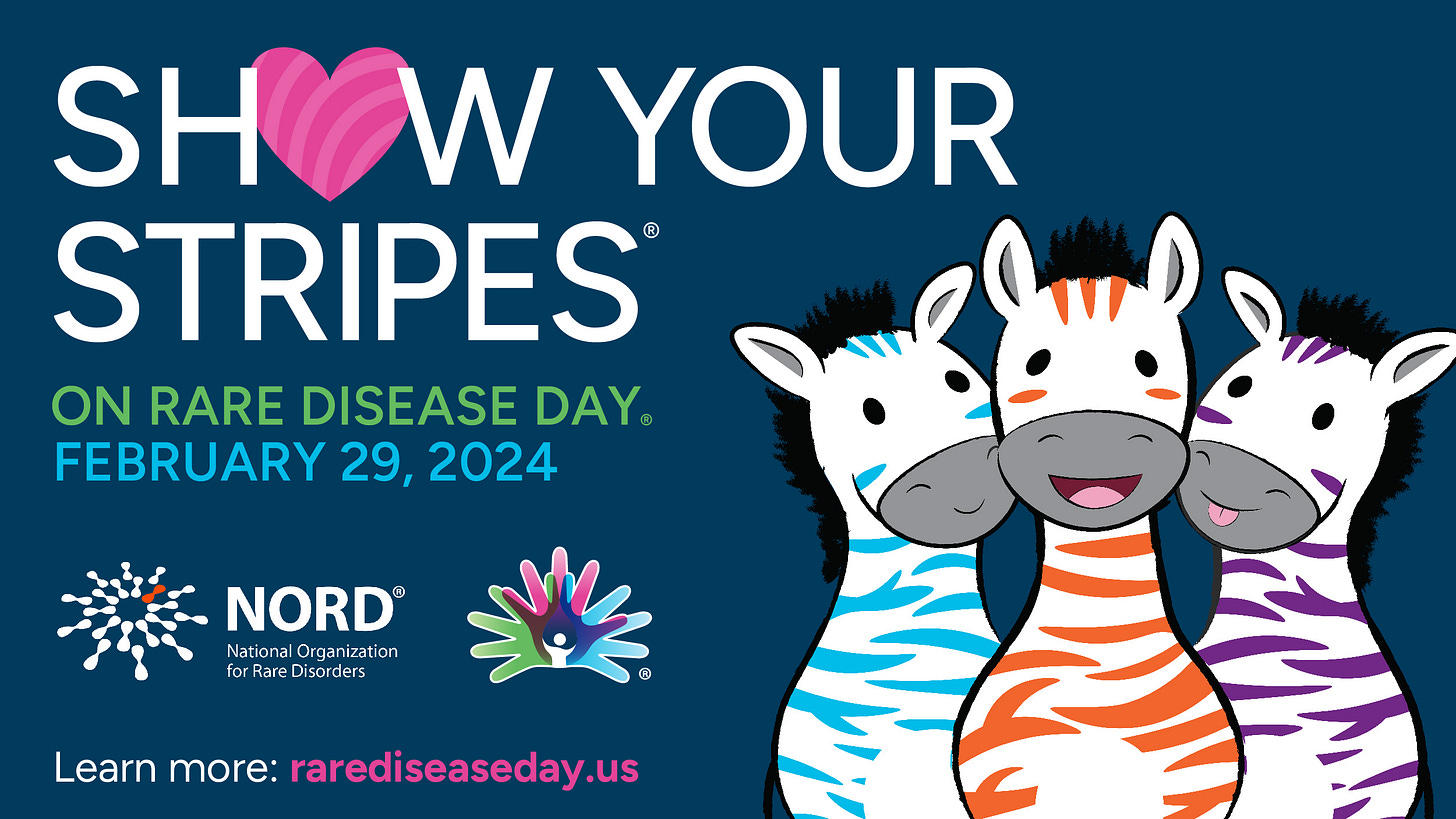
WHAT IS A RARE DISEASE?
According to the National Organization of Rare Diseases (NORD), any condition which affects less than 200,000 people in the United States is classified as a rare disease. Although individual conditions are classified as rare, having a rare disease is not as rare as people might think. Approximately 1 in 10 Americans and over 300 million people around the world are living with a rare disease. This has led NORD and people within the rare disease community to adopt the following phrase:
Rare is not rare.
The National Institutes of Health currently recognizes over 7,000 rare diseases, and that number is growing every year with improvements in research and genetic testing. However, despite these improvements and despite the fact that millions of people are walking this journey, it can be an extremely isolating one. Why?
Societal Stigmas: Stigmas surrounding illnesses and disabilities continue to isolate people living with these rare diseases every single day. People are looked down upon, harassed, abused, made fun of, and excluded simply because they have rare medical conditions and/or disabilities. Many times, their illness is viewed as fake because it is not easily identified by their community or their medical providers. This can make it challenging for people to seek and receive the care they deserve.
Lack of Resources: Great strides have been made in the educational and financial resources available to people with rare diseases and their families. However, there is still much room for improvement. Many families are unaware of grants and other financial assistance programs for which they qualify simply because they don’t know what’s available. They struggle to advocate for themselves or their loved ones because they don’t know what they should be advocating for. To put it simply, we don’t know what we don’t know. Additionally, some patients live far from resources that could help them, and lack the ability to travel due to the limitations of their conditions.
Misdiagnosis or Delayed Diagnosis: Speaking of advocacy, many patients and their families struggle to receive a diagnosis for their condition because they are brushed off by doctors and other healthcare providers who rely too heavily on the phrase “when you hear hoofbeats, think horses, not zebras.” The truth is, sometimes it is zebras. There are 30 million people in the United States who are living proof that sometimes, those hoofbeats are indicative of zebras. However, even when medical providers are doing their best to consider all of the possibilities, receiving a diagnosis for a rare disease can take years. Delayed diagnosis prevents patients from receiving the care they deserve, which greatly impacts their health and quality of life.
No Cures: Despite all of the advancements we have witnessed in medicine, “more than 90% of all rare diseases lack an FDA-approved treatment” (NORD, 2022). Over half of the people within the United States who have rare diseases are children (Kim & Shively, 2023). Think about that for a moment. Millions and millions of parents receive rare diagnoses for their children (if they are lucky enough to receive one), and they are often told that their is no cure, that there are limited treatment options to help with the symptoms their children experience, and that the condition they have could significantly reduce their lifespan.
Living with a rare disease and caring for someone with a rare disease is not a journey that we should have to walk alone, but millions of us are doing it on a daily basis. That’s why education matters. That’s why advocacy matters. That’s why organizations like NORD exist, and it’s why Rare Disease Day exists.
WHAT IS RARE DISEASE DAY?
In 2008, the very first day to honor rare diseases was organized in Europe by the European Organisation for Rare Diseases (EURORDIS, 2022). Since then, over 100 countries around the globe have joined the mission to spreading awareness of rare diseases in an effort to improve research and quality of life for the millions of people living with rare diseases. Rare Disease Day always occurs on the last day of February, because it is the rarest day of the year.
On Rare Disease Day, people all over the world hold events and spread awareness on social media to educate people about living with a rare disease. Buildings are lit up with blue, green, purple and pink lights to create a global chain of lights honoring people with rare diseases and their families. No matter where you are, you can join the cause. Click here to find out ways you can get involved.
The official mascot for Rare Disease Day is the zebra. The awareness ribbon is a zebra striped ribbon, and the awareness colors for Rare Disease Day are blue, green, purple, and pink. On February 29, consider wearing zebra stripes or one of the four awareness colors.
RARE IS NOT RARE
When interacting with people in the medical parenthood community or people with disabilities, you will likely hear about the impact of rare diseases and movements like Rare Disease Day. Take the time to listen to the experiences of those who live with rare diseases and those who care for them. Millions of people all over the world live with rare diseases every day, and their stories deserve to be heard.
Rare Disease Day is one day out of the year that we can stand together in solidarity, spread awareness, educate, and donate to organizations dedicated to research. This journey is a challenging one, but as more and more people join in this fight, we cultivate hope one step at a time. Join us and help us create a brighter future for all of those living with rare diseases.
THE WHY BEHIND “WORD OF THE WEEK”
Parenting children with disabilities and/or medical complexities can be an overwhelming journey. The children we are blessed to parent are miraculously strong, and they are a joy to love. However, the joy and love we experience is experienced in tandem with an incredible amount of stress on a daily basis.
Each day, parents are faced with an endless number of decisions they have to make. When you are a parent of a child with disabilities and/or medical complexities, though, the weight of these decisions often sits more heavily on your shoulders. Why? Because the decisions being made directly impact the very specialized care your child needs to thrive.
My name is Hillary. I am a licensed physical therapist with a doctorate level degree and multiple years of experience working in developmental pediatrics. For years I worked with children with variety of medical complexities, disabilities, and delays in their development and gross motor skills. Shortly after leaving the world of physical therapy, I found out that I was pregnant with our second child, and several months later, I discovered our daughter had many complications.
Our daughter, Marsaili, has Lissencephaly - a rare, terminal neurological disorder characterized by a reduction or absence of folds and grooves in the brain. Even with the background and knowledge that I have from my work as a physical therapist, this road, these decisions, and the amount of information we have to handle on a daily basis is overwhelming. It’s exhausting.
While medical providers often do the best they can to educate, many parents and caregivers still struggle to fully understand the intricate details of the child’s care. This isn’t necessarily because they are incapable of understanding. It may just be because they don’t know what questions to ask or what to advocate for when they are overwhelmed with a million other things. Sometimes you simply don’t know what you don’t know.
That’s what this section of my blog is all about - breaking down parts of this world into easy-to-understand, digestible pieces. It’s about making conversations like this feel like a cup of coffee with a friend (even when the topics discussed are a little heavier). It’s about making you feel like the amazing caregiver that you are - no matter what your educational background is - because you and your child deserve to understand the pieces of the puzzle. You deserve a chance to be your child’s best advocate, because that’s exactly what you are.
RESOURCES AND REFERENCES
National Organization for Rare Disorders (NORD). (2022, November 1). Rare disease facts and statistics: Nord. National Organization for Rare Disorders (NORD). https://rarediseases.org/understanding-rare-disease/rare-disease-facts-and-statistics/
Kim, K., & Shively, V. (2023, February 27). All about rare diseases and genetic disorders in children. Ann and Robert H. Laurie Children’s Hospital of Chicago. https://www.luriechildrens.org/en/blog/about-rare-diseases-and-genetic-disorders/
European Organisation for Rare Diseases. (2022). Our History. EURORDIS - Rare Diseases Europe. www.eurodis.org
*DISCLAIMER: The information provided in this blog and any other blogs by Hillary Ramos Substack - Joyful + Rising (“we”, “us,” or “our”) at https://substack.com/@joyfulandrising (the “Site”) is for general informational purposes only. All information on the Site is provided in good faith, however, we make no representation or warranty of any kind, expressed or implied, regarding the accuracy, adequacy, validity, reliability, availability, or completeness of any information on this Site.
This site cannot and does not contain medical/health advice. The medical/health information is provided for general informational and educational purposes only and is not a substitute for professional advice. Accordingly, before taking actions based upon such information, we encourage you to consult with the appropriate professionals. We do not provide any kind of medical/health advice.
Under no circumstance shall we have any liability to you for any loss or damage of any kind incurred as a result of the use of the Site or reliance on any information provided on the Site. Your use of the Site and reliance on any information on the Site is solely at your own risk.





